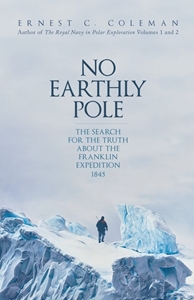New Franklin book seeks to set the record straight
No Earthly Pole, by Ernest C. Coleman
 Ernest C. Coleman has taken part in four expeditions to the Arctic to uncover the fate of the 1845 expedition led by Captain Sir John Franklin that took the lives of 129 men from HMS Erebus and HMS Terror.
Ernest C. Coleman has taken part in four expeditions to the Arctic to uncover the fate of the 1845 expedition led by Captain Sir John Franklin that took the lives of 129 men from HMS Erebus and HMS Terror.
In No Earthly Pole, Coleman is 'determined to set the record straight' as he sees it. Through recounting his own forays into the world’s bitter north, he seeks to highlight the endeavour, determination, labours and pains of men to benefit the rest of humanity by the establishment of a water passage from the Atlantic to the Pacific.
So much has been written about the ill-fated journey Franklin and his crews took to plot the North-West Passage that it has seeped into the popular consciousness. Theirs was a quest that had consumed some of Europe’s most accomplished mariners for almost four centuries. It was an obsession that chipped away at European understanding of North America’s extremities, sometimes at great cost to both vessels and lives.
And although the Franklin expedition was the best-equipped assault on the Passage launched at that time, its two vessels disappeared after sailing north from Baffin Bay. None of the men were ever seen by westerners alive again.
Many theories have been put forward for their demise. Rescue missions turned up tantalising clues: an abandoned sled, personal effects, letters from the crew, and two skeletons. But to this day the fate of Franklin himself remains unknown.
In Coleman’s opinion, some of the theories surrounding this ill-fated expedition have been shaped by political bias – taken over by academics and politicians both for questions of Canadian sovereignty and academic advancement. The author is scathing of these 'closed-minded' philosophies, which he says come at the cost of both Franklin and the Royal Navy’s reputation. 'That they did not succeed was not the fault of poor leadership, incompetence, foolhardiness, vanity or impracticality,' he says. 'Their misfortune was nothing more or less than the unpredictable conditions of environmental adversity.
A Royal Navy man himself, Coleman knows about environmental adversity. The first part of this 350-page hardcover book is dedicated to his explorations of the Canadian Arctic in search of surviving evidence from the 1845 expedition. In it he chronicles the sheer scale of that task in the world’s most extreme climate. There are mishaps and misadventures and the consequences of poor planning and bad judgement. Coleman may be a hardened adventurer in the vein of his hero Franklin, but he is no match for an Arctic summer storm nor immune to starvation.
The second part of the book is an examination of the 'misinformation that carried with it the disparagement and tarnishing of a great enterprise and the sullying of the memory of those who died whilst trying to survive it'. Coleman’s hypotheses might raise a few eyebrows in academic circles – exactly as they are designed to do. With images from his expeditions, including detailed maps and archaeological finds, No Earthly Pole certainly achieves its goal to speak out in opposition to those who have learned their history from textbooks, written by scholars who were in turn tutored by yet more books rather than first-hand experience of adversity. For Coleman, this type of learning has closed minds to the achievements of both Franklin and the Royal Navy in the Arctic. His lived experience could very well open some minds to a revised, more positive narrative of those early explorations and open a path to different types of
studies in future.
No Earthly Pole: The Search for the Truth About the Franklin Expedition 1845
By Ernest C. Coleman
Amberley
ISBN: 978 13981 02118
Buy this book in the Nautilus Bookshop
While you're there, why not browse the rest of the titles in our unique maritime bookshop, which sells all the books reviewed on these pages.
Buy nowMore Books
The precarious path from piracy to prosperity
The Resurrected Pirate, by Craig S ChapmanThe Resurrected Pirate is a remarkable story told in an engaging way, illustrating for the modern reader the desperately narrow passage between life and death that a seafarer in this period might have to navigate.
Carving out a career
Ships' Figureheads: Famous Carving FamiliesThe decoration of ships with figureheads was a way to present the might of military and mercantile power for centuries. These days, the skills needed to make these sculptures are kept alive by experts such as Andrew Peters, who has worked on restoration projects such as the Cutty Sark tea clipper.
Knotty problems solved
The Knot Bible: The Complete Guide to Knots And Their Uses by Nic ComptonKnot-tying is a vital competency skill for seafarers, and this expanded edition of The Knot Bible by Nic Compton offers guidance on over 200 knots and their practical uses.
Why it's nice to splice
Splicing modern ropes, 2nd edition: a practical handbook by Jan-Willem PolmanSplicing rope is as an essential skill for seafarers as tying a knot, but some skills are disappearing. This definitive guide on why splicing gets more from your rope is a great stocking filler for all boaters, whether recreational or commercial.
